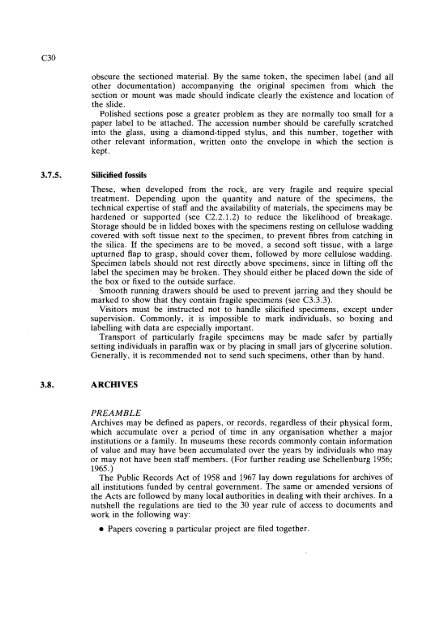GUIDELINES FOR THE CURATION OF GEOLOGICAL MATERIALS
GUIDELINES FOR THE CURATION OF GEOLOGICAL MATERIALS
GUIDELINES FOR THE CURATION OF GEOLOGICAL MATERIALS
You also want an ePaper? Increase the reach of your titles
YUMPU automatically turns print PDFs into web optimized ePapers that Google loves.
obscure the sectioned material. By the same token, the specimen label (and all<br />
other documentation) accompanying the original specimen from which the<br />
section or mount was made should indicate clearly the existence and location of<br />
the slide.<br />
polished sections pose a greater problem as they are normally too small for a<br />
paper label to be attached. The accession number should be carefully scratched<br />
into the glass, using a diamond-tipped stylus, and this number, together with<br />
other relevant information, written onto the envelope in which the section is<br />
kept.<br />
3.7.5. Silicified fossils<br />
These, when developed from the rock, are very fragile and require special<br />
treatment. Depending upon the quantity and nature of the specimens, the<br />
technical expertise of staff and the availability of materials, the specimens may be<br />
hardened or supported (see C2.2.1.2) to reduce the likelihood of breakage.<br />
Storage sbould be in lidded boxes with the specimens resting on cellulose wadding<br />
covered with soft tissue next to the specimen, to prevent fibres from catching in<br />
the silica. If the specimens are to be moved, a second soft tissue, with a large<br />
upturned flap to grasp, should cover them, followed by more cellulose wadding.<br />
Specimen labels should not rest directly above specimens, since in lifting off the<br />
label the specimen may be broken. They should either be placed down the side of<br />
the box or fixed to the outside surface.<br />
Smooth running drawers should be used to prevent jarring and they should be<br />
marked to show that they contain fragile specimens (see C3.3.3).<br />
Visitors must be instructed not to handle silicified specimens, except under<br />
supervision. Commonly, it is impossible to mark individuals, so boxing and<br />
labelling with data are especially important.<br />
Transport of particularly fragile specimens may be made safer by partially<br />
setting individuals in paraffin wax or by placing in small jars of glycerine solution.<br />
Generally, it is recommended not to send such specimens, other than by hand.<br />
ARCHIVES<br />
PREAMBLE<br />
Archives may be defined as papers, or records, regardless of their physical form,<br />
which accumulate over a period of time in any organisation whether a major<br />
institutions or a family. In museums these records commonly contain information<br />
of value and may have been accumulated over the years by individuals who may<br />
or may not have been staff members. (For further reading use Schellenburg 1956;<br />
1965.)<br />
The Public Records Act of 1958 and 1967 lay down regulations for archives of<br />
all institutions funded by central government. The same or amended versions of<br />
the Acts are followed by many local authorities in dealing with their archives. In a<br />
nutshell the regulations are tied to the 30 year rule of access to documents and<br />
work in the following way:<br />
Papers covering a particular project are filed together.

















